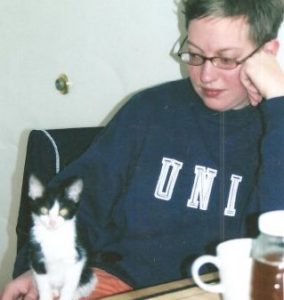 We’re fostering kittens again.
We’re fostering kittens again.
My wife is passionate about cats. In one of the first pictures I saw of her as a child, she’s proudly hugging a resigned Siamese to her little body. Without solicitation, she shows people pictures of our cats the way proud parents might show pictures of their children.
While there are people who genuinely hate dogs (or fear them), on the matter of cats, I’ve found people generally fall into two distinct categories: “Indifferent” and “fiercely obsessed.” In this way, cats are kind of like the U2 of domesticated animals.
I must admit, I fall into the former category. While yes, I love our cats, I’ve never been over the moon about the species. I’m firmly Team Dog—I like a dog’s simplicity, their easy emotional vocabulary and over-the-top joie de vivre about everything from treats to walks. I like that dogs’ emotional states are seldom mysterious. A dog is motivated by forces similar to my own motivating forces: Food, praise.
That said, my first pet, after moving into my first apartment, was a cat.
This was a practical choice. While cats cannot provide security, while their urine is ruinous, while they are five thousand years behind the dog evolutionarily, they require decidedly less maintenance than a dog. At 21, I wanted a furry companion, but recognized I lacked the discipline dog ownership entails.
Sid was a black-and-white tuxedo cat. I got him from friends of a co-worker. When I first brought him home, as a kitten, I made him a bed with an old concert T-shirt and a watch tucked into the folds having read somewhere that the ticking hands mimic a mother cat’s heart. He was weaned far too early, and I usually cited this fact while trying to explain away his off-putting aggression. Sid was a biter—not a play biter, but a for-no-discernable-reason-leap-up-and-draw-blood biter.
Sid bit me so frequently that my arms were covered in bruises and scabs, and I once went on a job interview in July wearing long sleeves so that my prospective employer didn’t see the marks and surmise that I was a junkie.
No one liked Sid, but I liked him. He was mine. I lived alone and he kept me company, listened to me talk, slept on my legs at night, purred in my lap while I read or watched television.
Three years after adopting Sid, I rose for work on Groundhog’s Day and found him inexplicably dead in the hallway between my galley kitchen and bedroom. Almost 20 years later, after meeting my wife, I’d tell her this story and she’d conclude that he had a heart defect common in domestic cats. I forget the name.
After I found him dead, I covered him with a bath towel, went onto my balcony that overlooked O’Hare, lit a cigarette and wondered what I was supposed to do with his body.
My mother and aunt drove over to collect him so I could go to work; my parents generously offered to bury him in their yard with the parakeets, hamsters and turtles of my youth, but it was February and the ground was hard, so Sid had to “lie in state” in my dad’s tool shed until it warmed up.
The grief I felt after Sid’s death was shocking to me in its sheer profundity. He was a cat. Just a cat. And yet I cried my way through boxes of Kleenex and rolls of toilet paper and felt indignant that there weren’t any sad love songs about the loss of a cat. (Full disclosure: The week after Sid died, I started crying in my car on the way to work when Nazareth’s “Love Hurts” came on the radio and to this day that song reminds me of my cat’s death.)
It wasn’t until I got married that I had cats again. Our animal family is a blended one. It began with my wife’s three cats and my dachshund, Bernie, who is remarkably gentle with his feline siblings in spite of the animus toward small creatures coded into his DNA.
Since getting married, we lost one elderly cat and adopted two more. There’s our handsome orange tabby named Fred, who I have deemed Number One Special Kitty because of his unwavering allegiance to me and me alone, and a run-of-the-mill brown and gray tabby I called Pill Bug because he was incredibly round. (He was a “foster fail.”)
After that failed foster attempt with Pill Bug, we have continued to foster successfully. We remind ourselves, adamantly, that we cannot keep the kittens. It’s easy to want to keep a kitten. They’re delicate and silly and small. We’re careful not to name our fosters. Once you’ve named an animal, you’ve claimed it (as we learned with Pill Bug). My wife reminds me, especially when I get incredibly cranky about the sheer number of animals in our house—animals who sometimes disrupt my sleep, walk across my keyboard, knock items off my dresser and vomit on the coffee table—that we’re doing a “good thing.” And I know this is true.
As I write this, a black kitten with an angular face is blissfully stretched out, napping in my lap. He weighs less than a soda can. I’d still prefer a puppy, but in this world, I’ll take my sweetness and tender simplicity wherever I can get it.
P.S. Spay/neuter your pets.

